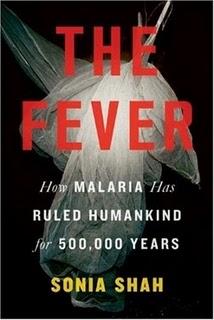The Fever: How Malaria Has Ruled Humankind for 500,000 Years

Vampire mania has taken hold and Sonia Shah’s The Fever goes back in time before Twilight and even Dracula to the first vampires: mosquitoes and their parasites. Shah tells a good story, and this story has everything from drama and risk to villains and exotic locations. The villain is malaria, the exotic locations cross the globe over the past millennia, and the drama and risk are life-and-death situations. Shah documents her research well and conveys a great deal of information about these unlovely Plasmodium parasites, and the mosquitoes that transmit them, without overwhelming the reader or becoming depressing.
This well-documented book covers historical, social, and medical aspects of the disease, its vectors, and human response in separate chapters. Chapters cover each topic chronologically; the chapter on medical research details competing theories from Italy and England, eventual collaboration from the United States, priorities that appall (including racist and classist application of prevention and treatment methods), and the scholarly conclusion that malaria (like everything) must be addressed locally and that efforts combating malaria must be informed by local conditions and life. This last has been ignored, with every effort to find a profitable magic bullet.
On one hand, it’s reassuring that malaria is not unique in this way. The same has been said, and ignored, about other public health issues like HIV; criminal issues like vice; and every feminist issue discussed beyond its social, ethnic, and cultural boundaries. On the other hand, it’s depressing that the same lessons are learned and forgotten in so many contexts. Shah’s investigation into the history of malaria renders her clear-eyed about the ways current efforts to combat malaria may be effective today, but lead to new resistance and a repeat of short-term gains followed by a resurgence once malaria is no longer chic for celebrities and donor organizations to campaign against. (The book was written before this year’s announcement that scientists have genetically engineered mosquitoes resistant to malaria parasites, and I look forward to Shah's opinion of this development.)
Shah places blame for the persistence of this scourge not only on malaria’s tenacity and ability to mutate quickly but also on profiteers from the Dutch colonizers of Indonesia to Novartis, geopolitical events, and vested interests. Some of these include the role of the Vietnam War in the proliferation of malaria; the denial of effective treatment; and apathy from people who live with malaria, a low priority among a long list of worries. But Shah is not full of invective. Rather, she explains why malaria is seen as a normal part of life in places where malaria is endemic, even as she explains that declines in rates of malaria are associated with decreased fatalities from all other diseases, prompting greater concern about a disease that compromises health and well being beyond its own deaths.
Lay readers of science will be interested in this book, as will anyone skeptical about coexistence with microbes or interested in public health efforts.